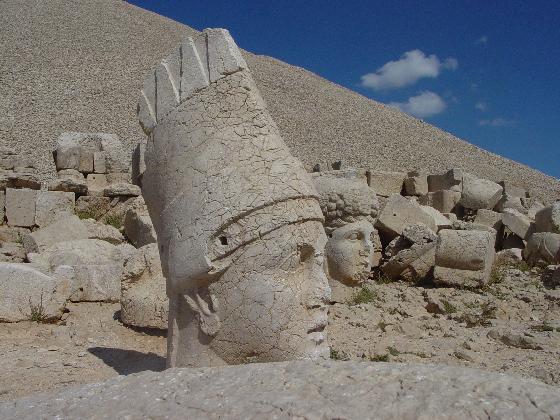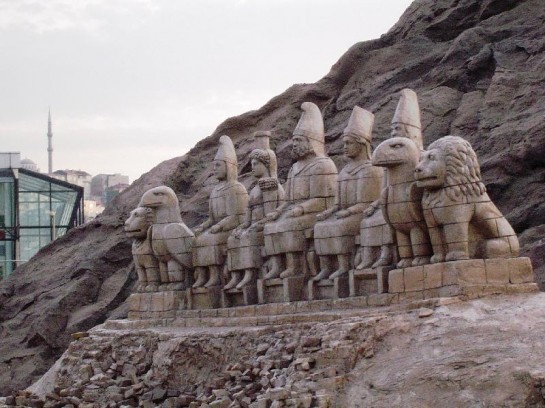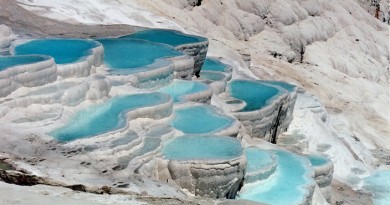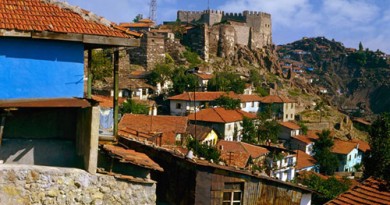Mountain Nemrut in Eastern Anatolia
 In the mountain Nemrut in Eastern Anatolia, Turkey there is a little known and indeed mysterious human creation. This is the tomb of the ruler Antiochus I of Commagene, which in the past was a kingdom to the north of Syria and the Euphrates. Maternal line he was a descendant of Alexander of Macedonia, and on behalf of his father came from the Persians and belong to the dynasty of Ahmadidars. Antiochus decided to build a majestic mound high atop mountain.
In the mountain Nemrut in Eastern Anatolia, Turkey there is a little known and indeed mysterious human creation. This is the tomb of the ruler Antiochus I of Commagene, which in the past was a kingdom to the north of Syria and the Euphrates. Maternal line he was a descendant of Alexander of Macedonia, and on behalf of his father came from the Persians and belong to the dynasty of Ahmadidars. Antiochus decided to build a majestic mound high atop mountain.
The building of sanctuary began in 62 BC No one knows how long it lasted construction, but the result is incredible. Burial mound is 50 m. High and 150 meters in diameter. So far, scientists have not been able to unravel the mystery of the great pyramid. In front of it were placed 5 huge statues higher by 9 meters each – 4 of Greek and Persian gods on the fifth Antiochus. They were carved from 5-ton stone blocks. As a result of frequent earthquakes in the area, or because of violent intervention, the heads of the statues are scattered on the ground.
Even fallen, they are amazed by its size – each of them is high about 2 meters. The heads with Greek features and hairstyles in the Persian style. Among them is that of the statue of Antiochus. This indicates that Antiochus himself was considered a god. In person he looks like Alexander of Macedonia and tiara talk about his belonging to the genus of Ahmadidars. The history of Commagene is less studied, but one thing is clear – this country it is lucky.
 The commercial crossroads of the ancient world is also a place for cultural meeting. Commagene proved exactly this point where encountered and mixed cultures of Western and Eastern world – Greece, Rome and Persia, the Parthian kingdom. The large arts have flourished in this little kingdom, whose population consisted mainly of peasants and traders.
The commercial crossroads of the ancient world is also a place for cultural meeting. Commagene proved exactly this point where encountered and mixed cultures of Western and Eastern world – Greece, Rome and Persia, the Parthian kingdom. The large arts have flourished in this little kingdom, whose population consisted mainly of peasants and traders.
But once, when there were favorable circumstances Commagene gave birth to a great work of art, doubly valuable because they are born in a country Lilliputian while remaining unique, no prototypes or analogs in any country of world.For all been guilty unbridled vanity of King Antiochus, ruler of Commagene. Maternal young king was a descendant of Alexander of Macedonia, and on behalf of his father came from the Persians belonged to the glorious dynasty of Ahmadidars. The king was young and proud. He sincerely believed himself perfectly extraordinary personality, united in one person Darius and Alexander born for great deeds and immortality. But how proud realize their dreams, when all your subjects have several thousand peasants and traders?
They are not prone to feats and neighbors with them will obey, a Roman legion is sufficient to wipe from the face of the earth kingdom. The king passed in noisy narrow streets of the capital and merchants dutifully prostrate and Antiochus declared god. The citizens accepted the news with restraint. Not objected. At the end of what will obey king – plain or immortal. The Pantheon of Commagene gods was quite complicated. On the one hand, the Greeks brought with them the cult of Apollo, Zeus, Fortuna. On the other, the population worshiped and the Persian gods – Mithra.
Even more, by putting these gods received additional names and almost every god represented several at once. It was very convenient for residents and commercial kingdom that had no time to deepen in the theological questions and the few priests who received pay for any god – both admirers of his first name, and the worshipers of the latter, and 3rd worshipers. The king Antiochus after failed to agree with the Romans to leave alone his realm, add yourself to the pantheon of major gods. This event was supposed to stay in the centuries. He made great sacrifices. Bet some of his possessions, he sold the family jewels gathered extraordinary taxes and ordered to begin erecting a temple to all the gods of Mount Nemrut, which towered over Samos.
King previously even thought of inscription for his sanctuary. And here we started the construction of the wonderful sanctuary dedicated to the gods of Europe and the Middle East and a thirst for glory living person – one young, energetic but unknowing where to apply his energy. At Nemrut top of the mountain, which rises two thousand meters were carved into the rocks three terraces, each several meters wide. On the upper terrace were placed in a number of five giant the size of a five-storey house. They are so big that their heads are more than two meters. The balconies were decorated with bas-reliefs depicting the king himself, his ancestors with their real and fictional exploits, but also horoscopes in which scientists were able to determine that the construction of the sanctuary began in 62 BC. The statues of lions Eagles kept terrace.
When construction was completed, the king commanded to draw a cobblestone path to the temple and “now and forever” twice a month to be carried out by all the people in solemn worship statues. Each month, the tenth day of celebrating the ascension to the throne of God Antiochus and sixteenth – in honor of his birth. Some time residents of the capital, of course, not everyone dutifully climbed the mountain marveling obvious why you god wanted to choose for his earthly residence is their small and peaceful country struggles in the mountains earthly subjects. And it does not even know when the last time the procession led by priests has gone up into the mountains. Or king really died in 38 BC as the story goes, or really she was immortal and when he tired of Commagene, went to reigning in heaven.
Then inhabitants of Commagene buried his mortal dust on top, as erected over the tomb 50 m,ters shiny marble pyramid and gradually forgot about Antiochus and his wonders. So Antiochus and his statues were forgotten for centuries until Karl Puhshtayn, German engineer, no stumbles of them, exploring the area in 1881. Two years later he returned with Karl Humam for more in-depth view, but only in 1953, a team of American archaeologists arrives and makes a full inquiry. Since then the place has become one of the most attractive in Turkey despite his remoteness.
Four columns circling the monument, each about 10 meters high and topped by huge figures of eagle and lav.Sled tomb began climbing the mountain chain of the Armenian Taurus. Nimrud, SFA clearly stands out against the other mountains with geometric regularity of its outlines. The climb is very complicated and tiring. Heat confuses breathing, stones falling down from the narrow path. And suddenly, after a turn is shown sanctuary majestically even now, after two thousand years. Under brilliant white cone of the pyramid on the top terrace has five statues. Only one has remained the head. This is the happy Fortuna.
The remaining statues have lost their heads; over two thousand years not once earthquakes have driven top of the mountain to tremble, soldiers from foreign armies have tried to destroy vague and therefore hostile. The main statues, reliefs and figures of beasts are made of wonderful masters; King Antiochus is not saving money for the best architects and sculptors of Persia and Rome. And maybe he finds them among their few subjects? It never know. King left inscriptions for himself and for his ancestors but has no names artists. The archeology expedition worked on a mountain top really in very difficult conditions – daytime temperatures rise to fifty degrees below zero at night fell, without water, without a speck of shade many miles around – for five seasons cleared the ruined sanctuary, freed from the terrace and stood six pieces rolling on the ground enormous heads. Four gods and two guards of the sanctuary – the lion and the gods eagle.
The heads facing terrace to their bodies, like the head of a miracle “Ruslan and Lyudmila”, especially the head of Zeus-Ahuramazda – the father of the gods. His short beard rings wrapped chin and eyes in high hat watch Persian alienated and away. It is the head of god Antiochus – a young, beautiful and also a high Persian tiara cap. In the face like Alexander of Macedonia and spoke tiara that belonged to the family of the Achaemenids. Persons of all statues are made according to the canons of Hellenistic art, but all gods, starting from the father of the gods Zeus and ending with Antiochus, have their heads high Persian caps crowns. The archaeologists completed their work. As a result of the five-year work was excavated and tidy the least known of the wonders of the world.
But although in 1958 archaeologists left top of the mountain, one of the secrets of Nimrud-SFA remained unsolved. Not guessed the secret of 50-meters pyramid. Why is it built? Really there is buried Antiochus, as imagined Teresa Hel, which opened to the sanctuary inscription: “The highest peak has one that is located to the heavenly throne of Zeus”. The ekspeditsiyata attempted to penetrate to the center of the pyramid, but blocks displaced and hidden initiated tunnel collapse. He had to retreat. Nobody knows what lies beneath pyramid. Some of the mysteries of Commagene managed to solve the German archaeologist Dorner, who in recent years was in charge of excavations in the vicinity.
In 1987 Nemrut was declared a World Heritage Site by UNESCO. It is one of the most important national parks in Turkey and it is the highest nature open-air museum in the world. Besides the statues entire site includes art from the Commagene civilization, Eskikale (Old Palace), Yenikale (New Palace), hill caracul and bridge Dendere. Most people use as a base camp nearby cities Malatya, Adiyaman and Kahta. The road to the top is open from mid-April to mid-October because of serious snow for the rest of the year. The top is one of the most remarkable monuments of the Hellenistic period with the charming beauty of monumental statues of the mausoleum of Antiochus First. They are located on the east and west terrace and it is good to see the sunrise and sunset, when they are bathed in light.


